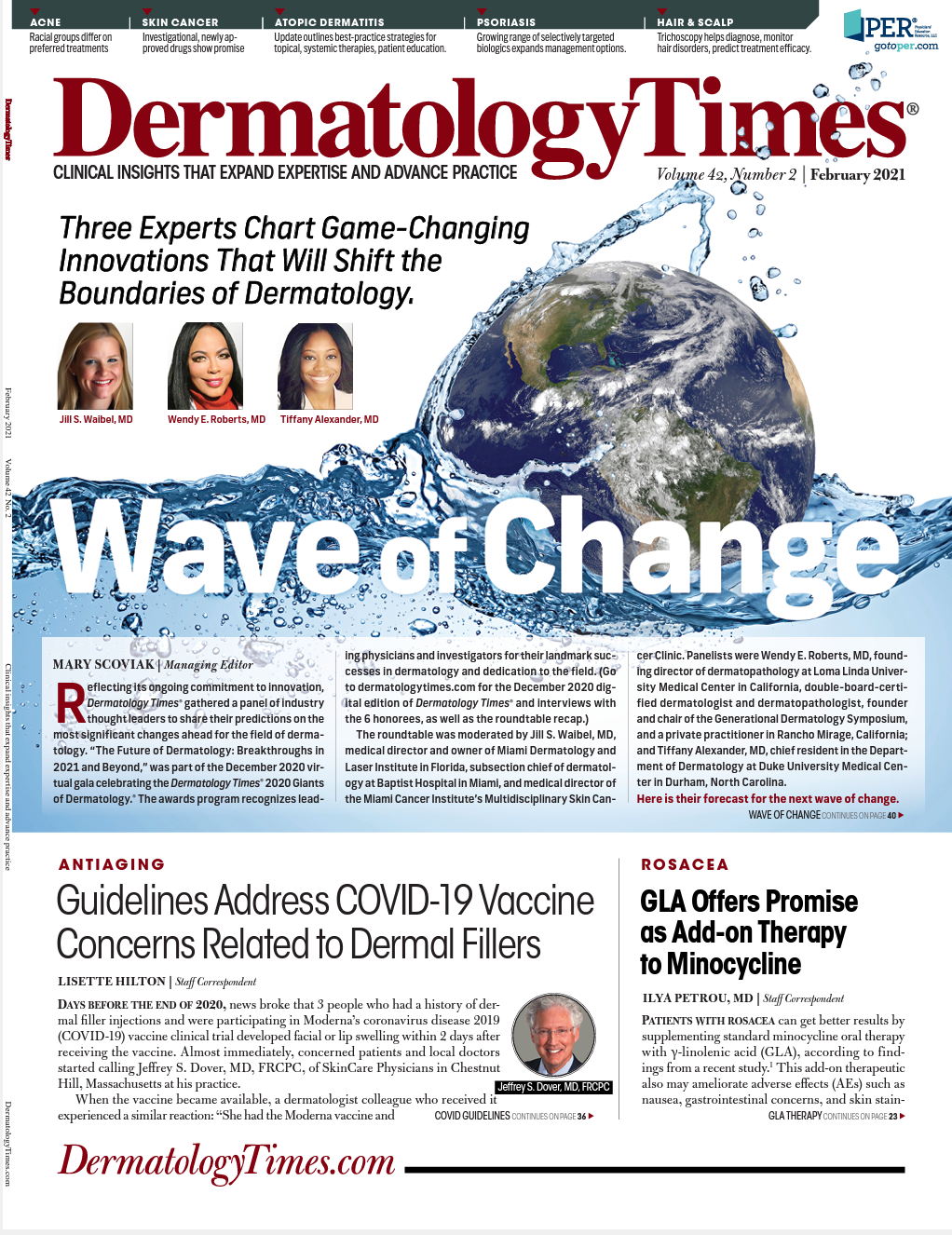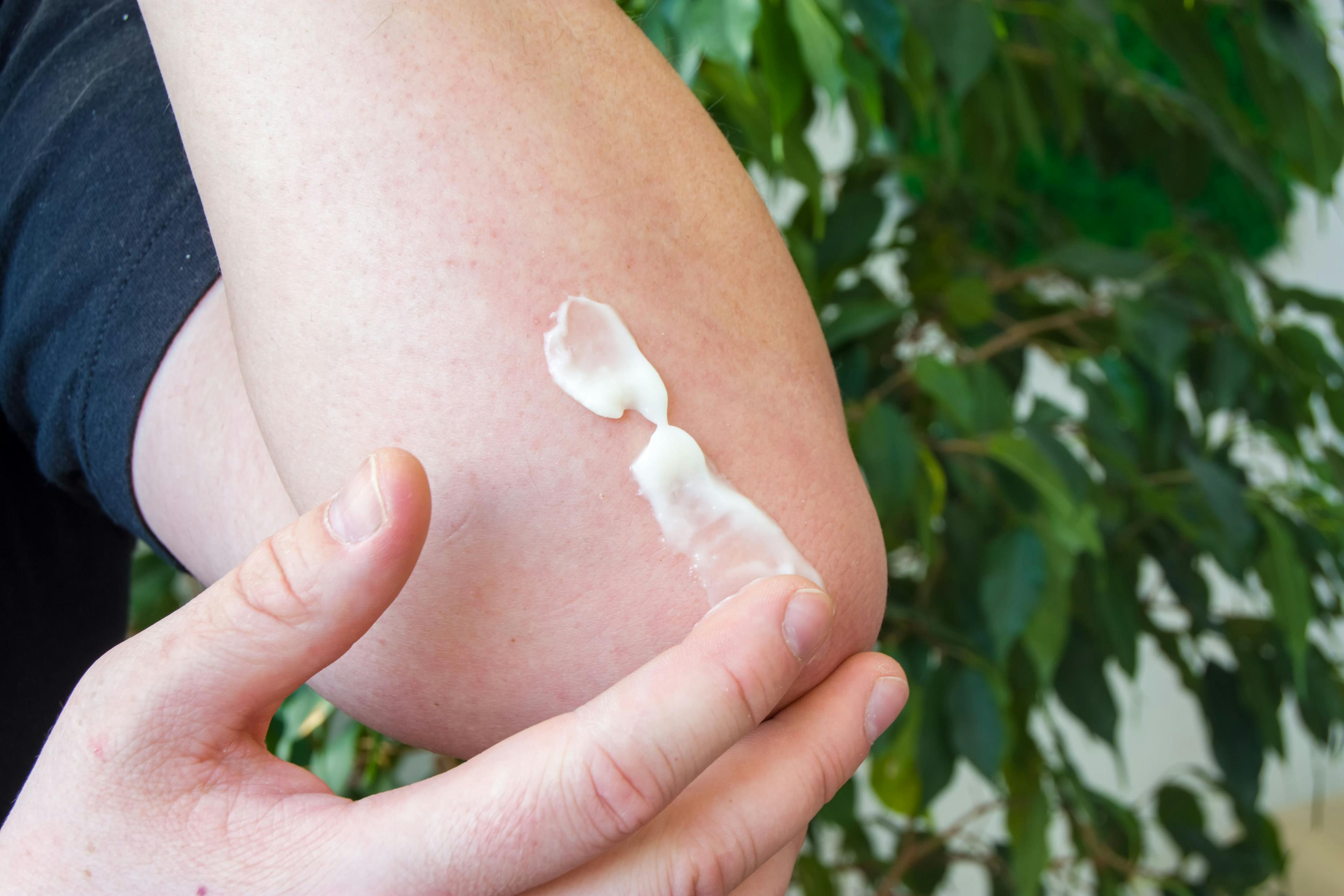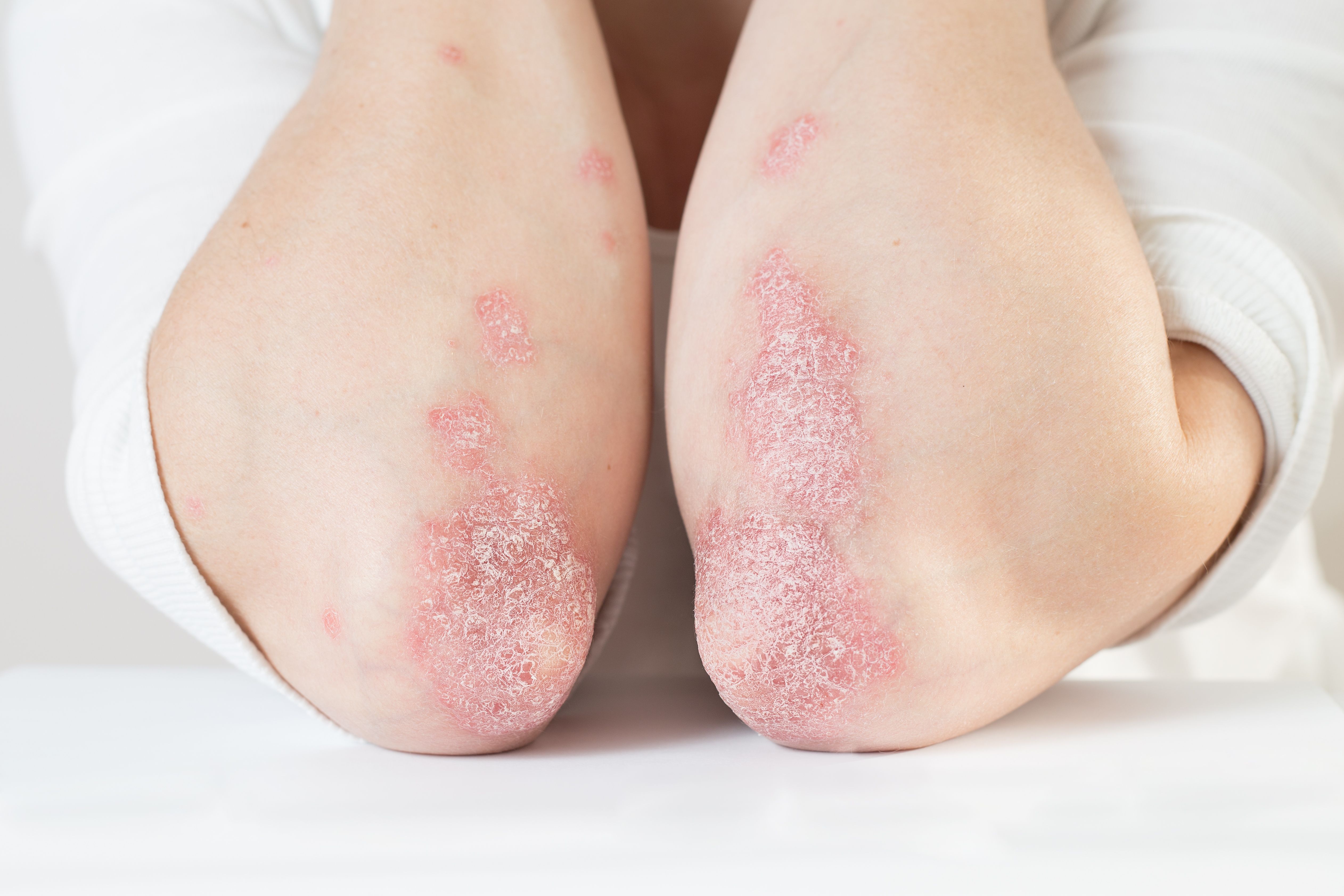- Acne
- Actinic Keratosis
- Aesthetics
- Alopecia
- Atopic Dermatitis
- Buy-and-Bill
- COVID-19
- Case-Based Roundtable
- Chronic Hand Eczema
- Chronic Spontaneous Urticaria
- Drug Watch
- Eczema
- General Dermatology
- Hidradenitis Suppurativa
- Melasma
- NP and PA
- Pediatric Dermatology
- Pigmentary Disorders
- Practice Management
- Precision Medicine and Biologics
- Prurigo Nodularis
- Psoriasis
- Psoriatic Arthritis
- Rare Disease
- Rosacea
- Skin Cancer
- Vitiligo
- Wound Care
Publication
Article
Dermatology Times
IL-17, IL-23 Inhibitors May Outperform Older Biologics, Oral Therapies
Author(s):
Several systemic therapies are currently available for the treatment of patients with moderate-to-severe psoriasis. Biologics changed the game for treatment. Continued study of and innovation in IL-17 and IL-23 inhibitors promise even better results, but clinicians need to understand each biologic in detail.
Biologics represent a huge step forward in psoriasis treatment, but their proliferation over the past few years makes it critical for clinicians to become familiar with each drug’s properties. Making the right decision for each patient means looking at more than one measure of efficacy or safety.
Beyond its cutaneous manifestations, psoriasis is recognized as a systemic disease that is associated with comorbidities including psoriatic arthritis, Crohn’s disease, uveitis, obesity, type 2 diabetes mellitus, dyslipidemia, hypertension, cardiovascular conditions, anxiety and depression. Finding an effective regimen that can achieve and maintain a high clearance of psoriatic lesions, as well as address the potential mosaic of comorbidities with minimal adverse effects, is the ideal treatment goal.
For patients with mild psoriasis, topical agents form the mainstay of treatment and include corticosteroids, vitamin D analogues, calcineurin inhibitors and keratolytics.
Patients experiencing moderate-to-severe psoriasis and psoriatic arthritis might receive systemic therapies including cyclosporine, methotrexate, apremilast (Otezla, Amgen) and retinoids, traditionally used to suppress the immune system and keratinocyte proliferation. However, the dermatologist’s growing armamentarium has generated much interest among clinicians and their patients with psoriasis; among the new tools: biologic agents, including inhibitors to tumor necrosis factor α (TNF-α) such as etanercept, infliximab, and adalimumab; IL-12 and IL-23 inhibitor ustekinumab (Stelara, Janssen Pharmaceuticals) ; IL-17A inhibitors secukinumab (Cosentyx, Novartis) and ixekizumab (Taltz, Eli Lilly and Co); IL-17RA inhibitor brodalumab; and IL-23 inhibitors guselkumab (Tremfya, Janssen Pharmaceuticals), risankizumab (Skyrizi, Boehringer Ingelheim/AbbVie Inc), and tildrakizumab.1 Two agents in the pipeline,Mirikizumab (Eli Lilly and Company) and bimekizumab (UCB), show strong results in phase 3 clinical trials.2,3
Pinpointing a Pathway
Investigators in the immunopathogenesis of psoriasis have identified IL-23 and IL-17 as fundamental contributors in the disease’s immune pathways. The discovery of the IL-23/T17 signaling pathway and significant therapeutic advances, including novel biologic therapy, have led to better treatment and management of psoriatic disease, according to a recent review paper.4
“The discovery of the roles for [IL-17] and IL-23 on the development of psoriatic disease has led to substantial increases in our understanding of the pathogenic immune events in psoriasis and has led to a paradigm shift in the treatment of this condition,” wrote Jim G. Krueger, MD, PhD, professor, senior attending physician and head of the Laboratory of Investigative Dermatology at The Rockefeller University in New York, New York, and fellow authors.
The FDA recently approved several inhibitors of the IL-23/IL-17 signaling axis for the treatment of psoriasis, which, according to the investigators, have proved very effective and result in significant improvements in 80% to 90% of patients with psoriasis.
“The unprecedented success of selective IL-17 and IL-23 antagonists for the treatment of psoriasis underscores the essential nature of these cytokines in the pathogenesis of this chronic inflammatory condition,” Krueger wrote.
Ellis et al appraised two network meta-analyses that assessed systemic therapies for patients with moderate to severe psoriasis and found that the newer biologic therapies targeting the IL-12/23 and IL-17 axes appear to be more effective than older biologics and oral agents, according to their recent paper.5
Notable Novel Biologics
The results of several clinical trials have shown novel biologic agents such as ixekizumaband guselkumab to be highly effective for patients with moderate to severe psoriasis.6-9 Recently approved by the FDA as the first selective IL-23 inhibitor for the treatment of psoriatic arthritis, guselkumab is a human immunoglobulin G1λ monoclonal antibody targeting the p19 subunit of IL-23, whereas ixekizumab is a human monoclonal antibody targeting IL-17A.
In a recent head-to-head study comparing the efficacy, safety and speed of response of the two biologics, 1027 patients with moderate to severe psoriasis were randomized to receive the approved dose of either subcutaneous ixekizumab or guselkumab. The primary end point was 100% improvement in the Psoriasis Area and Severity Index (PASI) 100 score at 12 weeks’ follow-up. Results showed that ixekizumab was superior to guselkumab for quickly improving signs and symptoms of moderate to severe psoriasis, meeting the primary end point (215 of 520, ixekizumab group [41%]; 126 of 507, guselkumab group (25%)]. According to the investigators, ixekizumab can completely clear moderate to severe psoriasis more rapidly than guselkumab, the IL-23 inhibitor.10
Choosing the Right Regimen
Other head-to-head clinical trials of secukinumab versus ustekinumab, ixekizumab versus etanercept and brodalumab versus ustekinumab have demonstrated the IL-17 antagonists’ superior efficacy.6,11,13
In another network meta-analysis study including 77 trials (34,816 patients), investigators assessed the relative efficacy of IL-17– and IL-23–targeted treatments for moderate to severe psoriasis, comparing the short-term efficacy of available (or imminently available) biologic and nonbiologic systemic therapies, reflected in the PASI response. Results showed that brodalumab, ixekizumab, secukinumab, guselkumab, and risankizumab were more efficacious than tildrakizumab, ustekinumab, all the TNF-α inhibitors, and nonbiologic systemic treatments for psoriasis. In terms of PASI 90 and PASI 100 response, data showed that brodalumab, ixekizumab, guselkumab and risankizumab demonstrated the greatest therapeutic benefits.14
Clinicians have an increasing number of selectively targeted biologic agents to better treat and manage patients with moderate to severe psoriasis. However, characteristics such as rapidity of onset, long-term efficacy, safety profile and effects on comorbidities vary among these therapies. Differentiating among the many novel biologic agents to find the ideal regimen can be daunting. Having a better understanding of each drug can help guide clinicians toward the best choice for each patient, minimizing the disease’s impact and boosting patient satisfaction and quality of life.
Disclosure: Krueger reports no relevant disclosures or financial interests.
References:
1. Armstrong AW, Read C. Pathophysiology, clinical presentation, and treatment of psoriasis: a review. JAMA. 2020;323(19):1945-1960. doi:10.1001/jama.2020.4006
2. Keown A. Eli Lilly’s mirikizumab hits the mark in phase III study, bests Cosentyx. BioSpace. July 17, 2020. Accessed January 14, 2021. https://www.biospace.com/article/eli-lilly-s-mirikizumab-bests-novartis-cosentyx-in-plaque-psoriasis-study-company-says
3. First presentations of bimekizumab phase 3 data demonstrate superior skin clearance over placebo and Stelara at week 16 in adults with moderate-to-severe plaque psoriasis. News release. UCB. June 12, 2020. Accessed January 14, 2021. https://www.ucb.com/stories-media/Press-Releases/article/First-Presentations-of-Bimekizumab-Phase-3-Data-Demonstrate-Superior-Skin-Clearance-Over-Placebo-and-Stelara-at-Week-16-in-Adults-with-Moderate-to-Severe-Plaque-Psoriasi
4. Hawkes JE, Yan BY, Chan TC, Krueger JG. Discovery of the IL-23/IL-17 signaling pathway and the treatment of psoriasis. Immunol. 2018;201(6):1605-1613. doi:10.4049/jimmunol.1800013
5. Ellis AG, Flohr C, Drucker AM. Network meta-analyses of systemic treatments for psoriasis: a critical appraisal. Br J Dermatol. 2019;180(2):282-288. doi:10.1111/bjd.17335
6. Griffiths CE, Reich K, Lebwohl M, et al; UNCOVER-2 and UNCOVER-3 investigators. Comparison of ixekizumab with etanercept or placebo in moderate-to-severe psoriasis (UNCOVER-2 and UNCOVER-3): results from two phase 3 randomised trials. Lancet. 2015;386(9993):541-551. doi:10.1016/S0140-6736(15)60125-8
7. Paul C, Griffiths CEM, van de Kerkhof PCM, et al. Ixekizumab provides superior efficacy compared with ustekinumab over 52 weeks of treatment: results from IXORA-S, a phase 3 study. J Am Acad Dermatol.2019;80(1): 70-79.e3. doi:10.1016/j.jaad.2018.06.039
8. Reich K, Griffiths CEM, Gordon KB, et al. Maintenance of clinical response and consistent safety profile with up to 3 years of continuous treatment with guselkumab: results from the VOYAGE 1 and VOYAGE 2 trials. J Am Acad Dermatol. 2020;82(4)936-945. doi:10.1016/j.jaad.2019.11.040
9. Blauvelt A, Papp KA, Griffiths CE, et al. Efficacy and safety of guselkumab, an anti-interleukin-23 monoclonal antibody, compared with adalimumab for the continuous treatment of patients with moderate to severe psoriasis: results from the phase III, double-blinded, placebo- and active comparator-controlled VOYAGE 1 trial. J Am Acad Dermatol. 2017;76(3):405-417. doi:10.1016/j.jaad.2016.11.041
10. Blauvelt A, Papp K, Gottlieb A, et al. A head-to-head comparison of ixekizumab vs. guselkumab in patients with moderate-to-severe plaque psoriasis: 12-week efficacy, safety and speed of response from a randomized, double-blinded trial. Br J Dermatol. 2020;182(6):1348-1358. doi:10.1111/bjd.18851
11. Blauvelt A, Reich K, Tsai TF, et al. Secukinumab is superior to ustekinumab in clearing skin of subjects with moderate-to-severe plaque psoriasis up to 1 year: results from the CLEAR study. J Am Acad Dermatol. 2017;76(1):60-69.e9. doi:10.1016/j.jaad.2016.08.008
12. Gordon KB, Blauvelt A, Papp KA, et al; UNCOVER-1 Study Group, UNCOVER-2 Study Group, UNCOVER-3 Study Group. Phase 3 trials of ixekizumab in moderate-to-severe plaque psoriasis. N Engl J Med. 2016;375(4):345-356. doi:10.1056/NEJMoa1512711
13. Lebwohl M, Strober B, Menter A, et al. Phase 3 studies comparing brodalumab with ustekinumab in psoriasis. N Engl J Med. 2015;373(14):1318-1328. doi:10.1056/NEJMoa1503824
14. Sawyer LM, Malottki K, Sabry-Grant C, et al. Assessing the relative efficacy of interleukin-17 and interleukin-23 targeted treatments for moderate-to-severe plaque psoriasis: a systematic review and network meta-analysis of PASI response. PLoS ONE. 2019;14(8):e0220868-10. doi:10.1371/journal.pone.0220868

Newsletter
Like what you’re reading? Subscribe to Dermatology Times for weekly updates on therapies, innovations, and real-world practice tips.






















